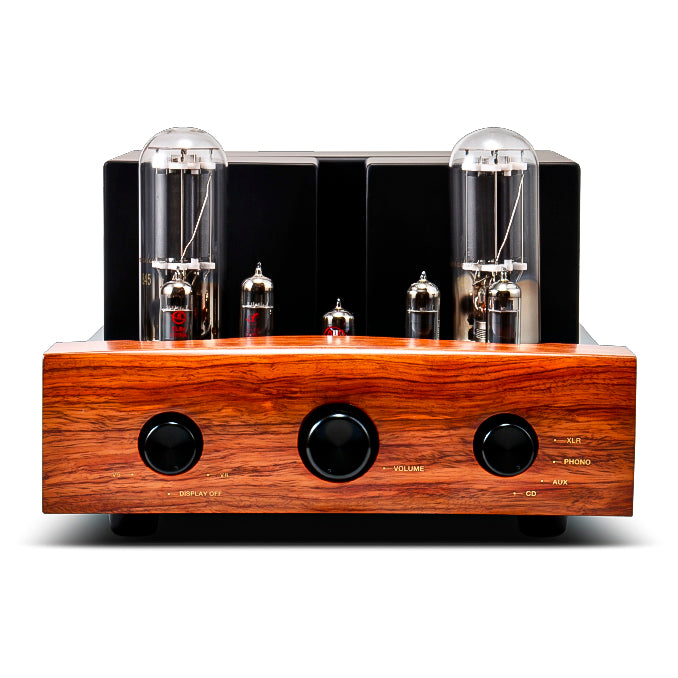■What is a "Phono equalizer"?
If you are unfamiliar with the term "phono equalizer," let me briefly explain that a phono equalizer is one of the essential functions for record playback.
Without this phono equalizer, records cannot be played back with accurate sound.
Click here for the product page of phono equalizer

Generally, when you want to play a CD on a player, simply connecting the output terminal of the CD player to the input terminal of the amplifier with a cable is sufficient, but in the case of records, they may not play properly.
A common occurrence is that you buy a record player and connect it to an amplifier in your house, but no sound is produced, or you hear only a "tinny sound like a mosquito flying".
What does this mean?
Unlike CDs, when you want to play a vinyl record on a player, you must connect it to the "PHONO IN" input jack on the amplifier side when connecting the record player to the amplifier, or you will hear no sound or only a low sound as described above.
Under normal circumstances, a Hi-Fi audio amplifier is equipped with a phono equalizer, so connecting it to the PHONO IN terminal on the amplifier side is all that is required.
On the other hand, most small amplifiers and mini-components on the market today do not have a phono equalizer.
To begin with, small amplifiers that do not have a phono equalizer do not have a PHONO IN terminal. In that case,Phono equalizer (Phono amplifier" or "phono preamplifier") is necessary.

Now, we have seen that a phono equalizer is essential for playing records.
But why do we need a phono equalizer?
■Two main functions of a phono equalizer
A phono equalizer has two functions.
The first is to increase the output level.
While the output signal from audio equipment such as a CD player is about 2V (volts), the output from a record player is a very small signal of 0.1 to 5mV (millivolts).
This is the reason why the sound is so quiet when heard through a small amplifier.
Therefore, the signal must be amplified to a sufficient output level.
The second is to restore the sound recorded on the record to its original sound.
When recorded on vinyl, bass tones are recorded low and treble tones are recorded high.
However, if this is not the case, the sound is not the original sound, and this must be restored.
The key word in this process is "RIAA curve.
By reversing the RIAA curve, we do the opposite of the way the record was recorded when it was played back through the phono equalizer.
In other words, it restores the original sound by making the bass louder and the treble lower.
To rearrange the role of the phono equalizer, it amplifies the very low output of the record and restores the original sound by correcting the bass and treble.
What is the RIAA curve?
First of all, "RIAA" stands for "Recording Industry Association of America," a worldwide standard established in 1952 for the purpose of standardization of analog records, which became today's standard in 1954.
At that time, just before the transition from monaural to stereo, there was a confusion of standards with slightly different curves depending on the record company, and the records played and the playback equalizer curves were different, so they did not play well.
The RIAA curve was then integrated into a single standard.
Click here for phono amplifiers that can handle various equalizer curves.
★Bakoon Products EQA-5640mk4 Phono Amplifier
★Bakoon Products CAP-1004 Multi-Curve Phono Equalizer

■Record Needles
There are generally two types of record needles (record cartridges), and depending on the type, it is important to know how they correspond to each other.
To begin, we will give a light explanation of the differences between cartridges.
MM (moving magnet) type cartridge
Most cartridges are MM (moving magnet) type.
They have a high output power, and by connecting a record player to an amplifier with a PHONO IN jack, you can easily enjoy listening to vinyl records.

MC (moving coil) type cartridge
MC (moving coil) type cartridges are considered to be more responsive in reproducing high frequencies and are generally more expensive than MM (moving magnet) type cartridges, but they are considered to have higher performance.
On the other hand, since the number of turns of the built-in coil cannot be increased, the output of the MC type is about 1/10 lower than that of the MM type, and the volume is too low when put directly into the PHONO IN terminal of an amplifier. Therefore, it is necessary to use a phono amplifier that is compatible with the MC type, or to use a step-up transformer to amplify the sound.
Record Cartridge Product Page
MC step-up transformer
MC cartridges have lower voltage than MM cartridges, so it is necessary to increase the voltage.
A transformer is used to boost the electrical signal from an MC cartridge.
Since the voltage is raised by using the turn ratio of the coil, a power supply is not required and powerful sound quality can be obtained.

To check, if your amplifier does not have a PHONO IN terminal for an MM-type cartridge, you will need a phono equalizer. If your amplifier does not have a PHONO IN terminal for an MC-type cartridge, you will need a step-up transformer and a phono equalizer.
Click here for the step-up transformer product page

























